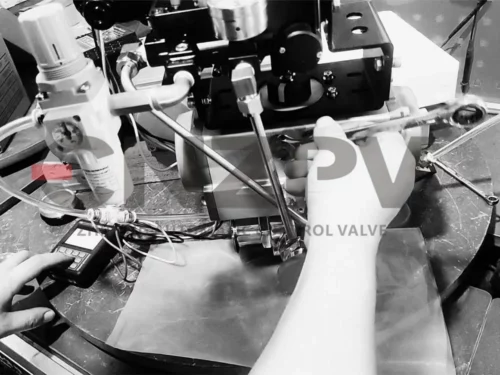
Menu
Menu
Menu
Nominal Diameter: DN15-350,NPS 1/2″-14″
Nominal Pressure: PN10-PN100,CL150-CL600
Connection Standard: HG20592-2009,ANSI B16.5,JIS B2220
Body Material: Nickel Alloy(N6)
Packing Type: Metal-Seal
Temp.Range: 600℃
Flow Characteristic: O-Notch For Shut-Off(Quick-Open)
V-Notch For Regulating (Equal percentage)
Actuator: Pneumatic,Electric
ISO 5211 ACTUATOR ASSEMBLY
N6, also known as No. 6 nickel, in addition to the physical and chemical properties of pure nickel, it also has the ability to resist strong alkali, neutral and weak acidity, and stable performance in the atmosphere, fresh water and seawater. At room temperature, the mechanical properties of N6 alloy are excellent, and its tensile strength, yield strength and elongation reach a high level. At the same time, N6 pure nickel also has good electrical and thermal conductivity, as well as excellent weldability.
High temperature properties of N6 nickel alloy
High temperature strength
N6 nickel alloy maintains good mechanical properties at high temperature. Usually at temperatures above 600°C, many materials lose strength, but N6 nickel alloys can still maintain high tensile strength at 800°C. Its tensile strength is 520 MPa at 800°C and 300 MPa at 1000°C.
Oxidation resistance
N6 nickel alloy has excellent oxidation resistance. This is mainly due to its high nickel content, which can form a stable nickel oxide protective layer at high temperatures. Experimental data show that N6 nickel alloy in 1000°C oxidation environment, after 100 hours of oxidation weight gain is only 0.1 mg/cm², which is significantly higher than other nickel-based alloys.
Coefficient of thermal expansion
The thermal expansion coefficient of N6 nickel alloy is low, about 13.0×10^-6/°C. This property is particularly important in high temperature environments, as the low coefficient of thermal expansion can reduce the dimensional deformation of the material under temperature changes, maintaining the dimensional stability and structural integrity of the component.
Heat resistance corrosion
N6 nickel alloy also exhibits excellent resistance to heat corrosion at high temperatures. Especially in corrosive atmospheres such as sulfides and chlorides, a dense nickel oxide film can be formed on the surface to prevent further erosion of the corrosive medium. The experiment shows that the corrosion depth of N6 nickel alloy is only 0.02 mm when exposed to high temperature in sulfur-containing environment for 500 hours.
Impact properties of N6 nickel alloy
Low temperature impact toughness
N6 nickel alloys not only perform well at high temperatures, but their impact toughness at low temperatures is also remarkable. The impact test shows that the impact toughness of N6 nickel alloy reaches 200 J/cm² at -196°C, which shows its good low temperature plasticity and anti-cracking ability.
Impact strength
At room temperature, the impact strength of N6 nickel alloy is also excellent. Standard impact test data show that its impact strength is 240 J/cm², which is much higher than the 100 J/cm² of ordinary steel. This means that N6 nickel alloys can effectively absorb energy when subjected to sudden shocks, reducing the risk of material breakage.
Dynamic fracture toughness
The dynamic fracture toughness of N6 nickel alloy is also very prominent. Fracture toughness test shows that at high strain rate (1×10^3 s^-1), its K_IC value reaches 100 MPa·m^0.5, which is of great significance for the application of materials under dynamic loads, especially in high-speed operation and strong vibration equipment, N6 nickel alloy can provide reliable material support.
N6 nickel alloy structural stability
Grain stability
The grain structure of N6 nickel alloy can remain stable when used at high temperature for a long time. This is mainly due to the fact that the trace elements in its alloy composition (such as titanium and aluminum) can effectively prevent the movement of grain boundaries and prevent grain growth. Relevant studies have shown that N6 nickel alloy is continuously used for 1000 hours at 900°C, and the grain size changes by less than 5%.
Stress relaxation property
N6 nickel alloy also has excellent stress relaxation properties at high temperatures. Under long-term loading at high temperature, the stress relaxation rate of N6 nickel alloy is low, about 10% (800°C, 1000 hours). This shows that the material can maintain high strength and good dimensional stability for a long time under high temperature conditions.
| Body/Bonnet Material | Nickel Alloy(N6) |
| Ball Material | Nickel Alloy(N6) |
| Seat Material | Nickel Alloy(N6) |
| Packing Material | V-PTFE,Flexible Graphite |
| Valve Type | Ball Valve |
| Temp. Range | ≤600℃ |
| Leakage Level | ANSI B16.104 Class IV |
| Flow Characteristic | ON-OFF |
| Ends | Flang(RF/FM),Welding |
| Flange Connection Standard | HG20592-2009,ANSI B16.5,JIS B2220 |
| Actuator (Linear Motion Type) | Pneumatic Piston Type |
| Electric Type |
※ Design Standard:GB/T12237;ASME B16.34
※ Face-To-Face: GB/T12221; ASME B16.10
※ Testing Standard: GB/T13927;API598
Feel free to drop us a message if you have any open questions and would like to work with us.